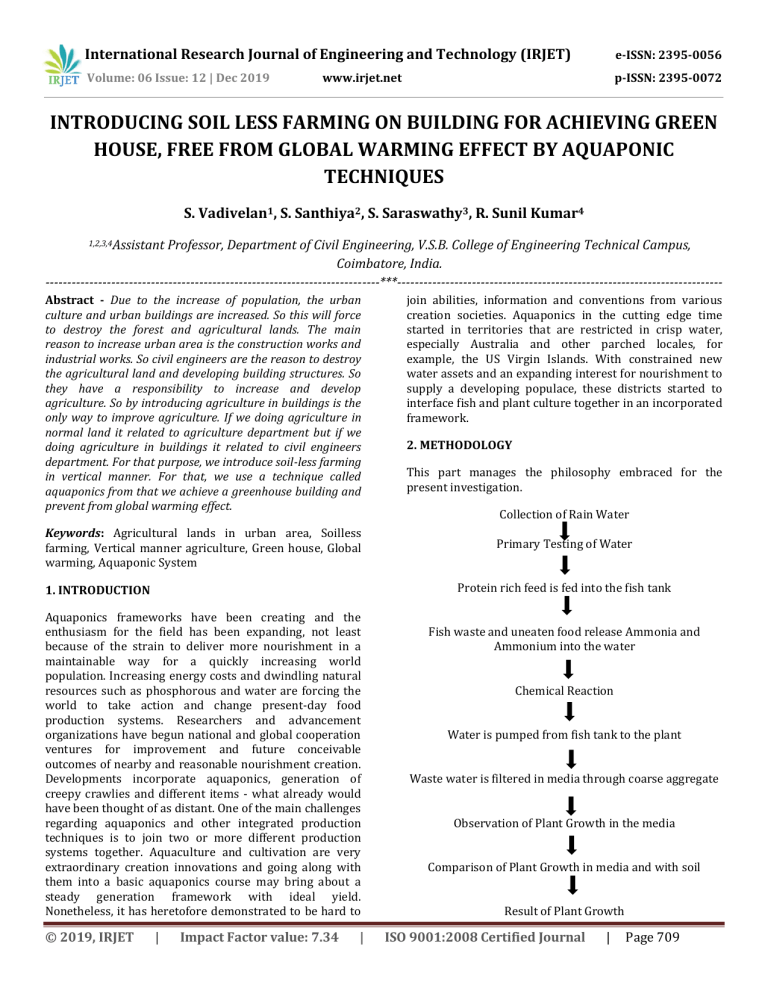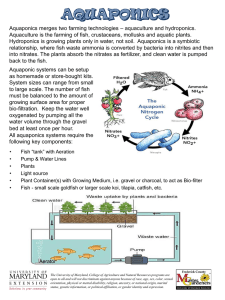IRJET- Introducing Soil Less Farming on Building for Achieving Green House, Free from Global Warming Effect by Aquaponic Techniques
advertisement

International Research Journal of Engineering and Technology (IRJET) e-ISSN: 2395-0056 Volume: 06 Issue: 12 | Dec 2019 p-ISSN: 2395-0072 www.irjet.net INTRODUCING SOIL LESS FARMING ON BUILDING FOR ACHIEVING GREEN HOUSE, FREE FROM GLOBAL WARMING EFFECT BY AQUAPONIC TECHNIQUES S. Vadivelan1, S. Santhiya2, S. Saraswathy3, R. Sunil Kumar4 1,2,3,4Assistant Professor, Department of Civil Engineering, V.S.B. College of Engineering Technical Campus, Coimbatore, India. ----------------------------------------------------------------------------***-------------------------------------------------------------------------Abstract - Due to the increase of population, the urban culture and urban buildings are increased. So this will force to destroy the forest and agricultural lands. The main reason to increase urban area is the construction works and industrial works. So civil engineers are the reason to destroy the agricultural land and developing building structures. So they have a responsibility to increase and develop agriculture. So by introducing agriculture in buildings is the only way to improve agriculture. If we doing agriculture in normal land it related to agriculture department but if we doing agriculture in buildings it related to civil engineers department. For that purpose, we introduce soil-less farming in vertical manner. For that, we use a technique called aquaponics from that we achieve a greenhouse building and prevent from global warming effect. Keywords: Agricultural lands in urban area, Soilless farming, Vertical manner agriculture, Green house, Global warming, Aquaponic System 2. METHODOLOGY This part manages the philosophy embraced for the present investigation. Collection of Rain Water Primary Testing of Water Protein rich feed is fed into the fish tank 1. INTRODUCTION Aquaponics frameworks have been creating and the enthusiasm for the field has been expanding, not least because of the strain to deliver more nourishment in a maintainable way for a quickly increasing world population. Increasing energy costs and dwindling natural resources such as phosphorous and water are forcing the world to take action and change present-day food production systems. Researchers and advancement organizations have begun national and global cooperation ventures for improvement and future conceivable outcomes of nearby and reasonable nourishment creation. Developments incorporate aquaponics, generation of creepy crawlies and different items - what already would have been thought of as distant. One of the main challenges regarding aquaponics and other integrated production techniques is to join two or more different production systems together. Aquaculture and cultivation are very extraordinary creation innovations and going along with them into a basic aquaponics course may bring about a steady generation framework with ideal yield. Nonetheless, it has heretofore demonstrated to be hard to © 2019, IRJET join abilities, information and conventions from various creation societies. Aquaponics in the cutting edge time started in territories that are restricted in crisp water, especially Australia and other parched locales, for example, the US Virgin Islands. With constrained new water assets and an expanding interest for nourishment to supply a developing populace, these districts started to interface fish and plant culture together in an incorporated framework. | Impact Factor value: 7.34 | Fish waste and uneaten food release Ammonia and Ammonium into the water Chemical Reaction Water is pumped from fish tank to the plant Waste water is filtered in media through coarse aggregate Observation of Plant Growth in the media Comparison of Plant Growth in media and with soil Result of Plant Growth ISO 9001:2008 Certified Journal | Page 709 International Research Journal of Engineering and Technology (IRJET) e-ISSN: 2395-0056 Volume: 06 Issue: 12 | Dec 2019 p-ISSN: 2395-0072 www.irjet.net 3. CONSTRUCTION OF AQUAPONIC SYSTEM 3.4. Gravel Media Bed 3.1 Collection of Rainwater from building The coarse aggregate were arranged based on their angularity for avoiding the entry of waste water into the fish tank. During the blustery season, the water was gathered in the fish tank. The gathered water was siphoned to the vertical developing media Fig - 4: Gravel Arrangement Fig -1: Collection of rainwater 4. TESTING RESULTS AND OBSERVATION OF PLANT GROWTH 3.2. Gravel Bed The vertical pipe was filled by coarse aggregate without soil. 4.1. pH test The pH test was conducted by using Litmus paper. The pH test was conducted on the rain water that we collected from the building for the survival of aquatic life. Fig -2: Vertical Growing Media of Plants Fig -5: pH Value 3.3. Construction of fish tank The water was tried for the development of fish. The water ought to have the pH of 5.5 there the fish can endure. The test result was 6.8. Therefore it is not harmful to the aquatic life. 4.2. Ammonia Test This test was conducted to check the level of waste released by the fish. The test result observed was 1ppm Fig -6: Level of Ammonia in Water Fig -3: Construction of fish tank © 2019, IRJET | Impact Factor value: 7.34 | ISO 9001:2008 Certified Journal | Page 710 International Research Journal of Engineering and Technology (IRJET) e-ISSN: 2395-0056 Volume: 06 Issue: 12 | Dec 2019 p-ISSN: 2395-0072 www.irjet.net 5. OBSERVATION OF PLANT GROWTH IN THE GRAVEL BED The growth of plant in the growing media was increased day by day. 7. CONCLUSION In urban areas all the forest and agricultural lands are destroyed due to construction of new buildings. So it is our responsible to increase the field of agriculture using building itself. Hence we introduced the soil-less agriculture system called Aquaponics. In auqaponics the plants are grown in vertical manner and also it gives aesthetic appearance to the buildings. Therefore the building will act as Green Building which is free from global warming. We are getting by- product from the plants for our daily domestic use. Compared to plant growth in soil, the growth of plant is aquaponics system is hasty. Even though we were using recycled water in the fish tank it was harmless for the fish to exist. The byproduct that we are getting from the plants are harmless for human beings. REFERENCES [1]. Ahmad, M.H. (2008). Response of African catfish, Clarias gariepinus, to different dietary protein and lipid levels in practical diets. Journal of the World Aquaculture Society 39:541-548. Fig -7: Growth of plant in gravel media [2]. Al-Hafedh, Y.S., Alam, A. and Beltagi, M.S. (2008). Food production and water conservation in a recirculating aquaponic system in Saudi Arabia at different ratios of fish feed to plants. Journal of the World Aquaculture Society, 39:510-520. [3]. Bernstein, S. (2011). Aquaponic gardening: a step-bystep guide to raising vegetables and fish together ISBN 978-0-86571-701-5. Fig -8: Growth of plant at 24th day 6. COMPARISON OF PLANT GROWTH BETWEEN AQUAPONIC METHOD AND NORMAL METHOD Observations were done at morning daily at 9.00am [4]. Braungart, M., McDonough, W. and Bollinger, A. (2007). Cradle-to-cradle design: creating healthy emissions - strategy for eco-effective product and system design. Journal of Cleaner Production, 15(1314): 1337-1348. [5]. Chapman, D. (Ed.) (1998). Water quality assessments. E & FN Spon, London. [6]. Chen, S., Ling, J. and Blancheton, J.P. (2006). Nitrification kinetics of biofilm as affected by water quality factors. Aquac. Eng., 34:179–197. [7]. Dalsgaard, J. and Pedersen, P.B. (2011). Solid and suspended/dissolved waste (N, P, O) from rainbow trout (Oncorynchus mykiss). Aquaculture,313:9299.doi.org/10.1016/j.aquaculture. 2011.01.037 Fig -9: Comparison of Plant growth in with and without soil © 2019, IRJET | Impact Factor value: 7.34 | [8]. Dalsgaard, J., Lund, I., Thorarinsdottir, R., Drengstig, A., Arvonen, K. and Pedersen, P.B. (2012). Farming ISO 9001:2008 Certified Journal | Page 711 International Research Journal of Engineering and Technology (IRJET) e-ISSN: 2395-0056 Volume: 06 Issue: 12 | Dec 2019 p-ISSN: 2395-0072 www.irjet.net different species in RAS in Nordic countries: Current status and future perspectives, AquaculturalEngineering.doi:10.1016/j.aquaeng.2012. 11.008 [9]. Danaher, J.J., Rakocy, J.E., Shultz, R.C., Bailey, D.S. and Pantanella, E. (2011) Dewatering and composting aquaculture waste as a growing medium in the nursery production of tomato plants. Acta Hort.(ISHS)891:223229.doi.org/10.17660/ActaHortic. 2011.891.26 [10]. Dediu L., Cristea V. and Xiaoshuang, Z. (2012). Waste production and valorization in an integrated aquaponic system with bester and lettuce. African Journal of Biotechnology 11 (9):2349-2358. [11]. DeLong, D.P., Losordo, T.M. and Rakocy, J.E. (2009). Tank culture of tilapia. SRAC Publication 282. South Regional Aquaculture Center. [12]. El Sayed, A.F.M. (2006). Tilapia culture. CABI Publishing, Wallingford, UK 70-94. [13]. Endut, A., Jusoh, A., Ali, N., Wan Nik, W.B. and Hassan, A. (2010). A study on the optimal hydraulic loading rate and plant ratios in recirculation aquaponic system. Bioresource Technology 101:1511– 1517. © 2019, IRJET | Impact Factor value: 7.34 | ISO 9001:2008 Certified Journal | Page 712






